Knowledge Management 101: Knowledge Management Cycle, Processes, Strategies, and Best Practices
By Becky Simon | August 28, 2017 (updated August 11, 2023)
- Share on Facebook
- Share on LinkedIn
Link copied
Regardless of industry or product, all companies rely on the knowledge of their employees to be successful. Organizations must treat knowledge as an asset, but it’s not enough to simply hire skilled employees. Instead, successful companies should build in processes to store, grow, and share knowledge to increase the knowledge base of the overall workforce. This concept is known as knowledge management.
In this article, you’ll find everything you need to know about knowledge management: what it is, types of knowledge, and the history and evolution of the field. Then, we’ll break down the benefits and challenges of implementing knowledge management, and discuss multiple models of the knowledge management life cycle. Finally, we’ll look at the rise of knowledge management systems, and offer free, downloadable templates to get you started building a knowledge management plan.

What Is Knowledge Management?
Knowledge management (KM) is the process(es) used to handle and oversee all the knowledge that exists within a company. Knowledge management relies on an understanding of knowledge, which consists of discrete or intangible skills that a person possesses.
The field of knowledge management identifies two main types of knowledge. Explicit knowledge is knowledge or skills that can be easily articulated and understood, and therefore easily transferred to others (this is also called formal or codified knowledge). Anything that can be written down in a manual - instructions, mathematical equations, etc. - qualify as explicit knowledge. Tacit knowledge , by contrast, is knowledge that is difficult to neatly articulate, package, and transfer to others. These are usually intuitive skillsets that are challenging to teach, such as body language, aesthetic sense, or innovative thinking. (A third knowledge type is implicit knowledge , which is information that has not yet been codified or transferred, but that would be possible to teach. Implicit knowledge is different from tacit knowledge, which is unlikely to be able to be codified. For this article, however, we will primarily discuss explicit and tacit knowledge.)
You can break these knowledge types down further into four categories:
- Factual Knowledge is measurable, observable, and verifiable data.
- Conceptual Knowledge relates to perspectives and systems.
- Expectational Knowledge is knowledge rooted in expectations, hypotheses, or judgments.
- Methodological Knowledge deals with decision-making and problem-solving.
Knowledge management enables organizational learning, a concept where companies are invested not only in the reliable, expert production of a product or service, but in the knowledge that underlies these production processes. Companies devoted to organizational learning are interested in maintaining and building upon internal knowledge at an organizational level - not just helping individuals accrue special skills, but ensuring that this knowledge is available to and dispersed throughout the workforce.
As one Massachusetts Institute of Technology (MIT) paper states, the core goal of knowledge management is to connect “knowledge nodes” - those with knowledge and those seeking knowledge - to ultimately increase the knowledge within an organization. Within that goal, the authors identify four objectives of KM: to capture knowledge, to increase knowledge access, to enhance the knowledge environment, and to manage knowledge as an asset.
Ultimately, knowledge management is an integrated system of accumulating, storing, and sharing knowledge within a team or organization. KM consists of several components, as well as strategies to implement it successfully - we’ll delve deeper into these later in the article.
Who Uses Knowledge Management?
Knowledge management can be implemented enterprise-wide across a number of industries. However, the way you implement KM might change depending on factors such as industry and company size.
KM is often used differently for small vs. large organizations, however. Small (and/or young) companies must carve out a competitive market advantage early on, and therefore benefit from KM by codifying and storing internal knowledge from the get-go. Large organizations - even those with unwavering strength in their market - use KM to act quickly in the digital age, where business changes constantly and often without warning. Without a reliable system to store existing knowledge and accumulate new knowledge, it would be difficult to react to these market changes. However, both large and small companies can benefit from KM because it treats the knowledge that every individual brings as an asset, so employees feel respected for their skills in the workplace.
For those looking to implement knowledge management in a specific department, you can also tailor the practice to sub-fields. Other than enterprise KM, knowledge management is most commonly implemented in IT/information systems and science, organizational management, business administration, human resources management, content management, or for personal use.
History of Knowledge Management
Efforts to formally manage knowledge have been in place for most of the past half century. In the late 20th century, however, with the evolution of computers, organizations began implementing more reliable storage systems. In the 1990s, the Swedish financial service provider Skandia created the first Chief Knowledge Officer (CKO) position, which paved the way for other companies to treat knowledge management as an integral part of their structure.
In fact, several academics have formalized the topic, and knowledge management is now regarded as a scientific discipline. In the mid-1990s, Ikujiro Nonaka and Hirotaka Takeuchi published the first academic research on knowledge management, and coined the SECI model (socialization, externalization, combination, internalization) as a path of knowledge transfer. Since then, Nonaka and Takeuchi have studied several other aspects of knowledge within a company, as have other academics. The knowledge management life cycle, which details how to store and disseminate knowledge throughout an organization, was also set forth by business academics in the l990s and early 2000s; the four most popular models are Wiig (1993), Zack (1996), Bukowitz and Williams (2000), and McElroy (2003).
In general, knowledge management has evolved from a loose tendency to accumulate, store, and teach (and therefore increase) knowledge within a team or organization into a prioritized method of building a knowledgeable workforce - all with the goal of gaining a competitive advantage. As we will discuss later on, there are several theories of how to best store knowledge and stimulate knowledge transfer within an organization. Skeptics say that today’s knowledge management is simply a “fad,” while others argue that its principles are here to stay: its strategies, methods, and implementation systems will simply continue to evolve as technology and business does, too.
What Is the Primary Benefit of Knowledge Management?
While it may not seem directly related to the tactics of knowledge management, the primary goal is to increase company efficiency to improve business decision-making. The idea is that building expertise into your organization - and dispersing it amongst employees - empowers you to make more informed, faster, and ultimately more profitable decisions.
Of course, there are several secondary benefits. Successful KM will enable you to:
- Increase collaboration and idea generation
- Optimize a culture of knowledge sharing
- Protect intellectual capital
- Treat human capital as an asset (which makes employees feel respected for their knowledge)
- Capture and store knowledge for the future workforce

Kevin D. Murray, CPP, CISM is a technical surveillance countermeasures (TSCM) specialist with an extensive career in information security and counterespionage consulting for business and government. He breaks the benefits of KM into four value areas:
Control: Not knowing where your information is is the first step to losing it.
Security: ‘You gotta keep the bait in the bucket, not in the pond.’
Access: When you need your information, you will get it faster.
Responsibility: With all the eggs in one basket, one is forced to carry the basket more carefully, meaning you provide better protection for your information.
RELATED: [Infographic] How Much Time Are You Wasting on Siloed Information?
What Are the Challenges of Knowledge Management?
There are many challenges that businesses face when implementing knowledge management. Here is a list of some of the most common ones:
- Creating a culture of flexibility and collaboration: This is one of the most significant and enduring challenges of KM. Companies already struggle to implement new policies, because people naturally tend to resist change. However, KM can be especially difficult because employees might want to protect their skills and knowledge, or be reluctant to learn from their peers.
- Security: You have to design a knowledge transfer system that makes it easy for the appropriate people to access information, while protecting sensitive or private intelligence from outsiders.
- Measuring knowledge: It can be difficult to define metrics to measure the knowledge within your organization, especially for tacit knowledge that cannot be easily quantified. To overcome this, some experts recommend focusing on the purpose of knowledge, rather than the efforts or results (which are often also unquantifiable).
- Identifying an expert: There won’t always be a single “keeper” of every knowledge type, but you will still have to identify who within the company possesses certain knowledge, and use them as the base level of knowledge from which you want to build. This process is difficult tactically, but can also be delicate among employees who might feel competitive about their skill levels.
- Document storage and management: While not all knowledge makes for straightforward documentation, it will have to be stored and organized in some form. Document management is a challenge for many companies, but organization is a vital aspect of KM - otherwise, it will be impossible to locate and use the knowledge you have stored. Consider using a dedicated document management system to keep everything organized.
- Disseminating knowledge throughout an organization: You’ll need to devise a process where, once you store the knowledge, other team members can access it. This is complicated both theoretically and tactically, so many organizations opt for a software system designed specifically for this purpose. We’ll take a closer look at KM systems later on.
- Continual improvement: Like most process-driven strategies, you should continually improve upon the knowledge management system you implement. Stage periodic reviews or, if possible, dedicate resources to continually optimize your process.
- Determining where KM is housed: If KM serves your entire organization, decide which department will “own” the strategy. Companies most commonly house KM in HR or IT. Remember, this department is not only responsible for effectively managing the knowledge itself, but also for maintaining the community of knowledge sharing and organizational learning.
How Does Knowledge Management Work? Basic Components and Strategies
As we’ve discussed, the theory behind knowledge management is that in order to make the best business decisions, the workforce must be as educated and skillful as possible. One way to ensure an educated - and continually learning - workforce is to stimulate organizational learning, which companies can do by implementing knowledge management. This practice ensures not only that existing knowledge (both explicit and tacit forms) is codified and stored, but that it can be dispersed among other employees so that people can continue to amass skills. Another benefit is that KM evenly distributes knowledge so no one is contributing in silos.
As Nonaka and Takeuchi first stated in their seminal academic papers, there are three main ways that people approach knowledge management:
- People-centric: Centered on people, relationships, and how people form learning communities and other informal ways of knowledge sharing. This idea is also known as ecological KM theory .
- Tech-centric: Focused on the technology that facilitates knowledge storage and transfer, and aims to create technology systems that encourage knowledge sharing.
- Process-centric: Interested in how the organizational structure and processes accommodate and encourage knowledge sharing and organizational learning. This concept includes the production processes, the organizational hierarchy, and the cultural framework.
The approach you take will depend on how your company currently functions. Organizational structure, politics, management style, and existing processes all create parameters around what kind of KM implementation is workable. Regardless of the approach you choose, however, implementing KM will inevitably affect your organization’s people, technology, and processes. Therefore, it’s best to keep all three in mind when enacting a knowledge management strategy.
Theoretical approaches aside, there are some common tactical ways of handling knowledge. The common strategies include:
- Storing knowledge vs. sharing knowledge: Storing knowledge involves accumulating, codifying, and maintaining knowledge in a reliable storage system. This is a good first step, but successful knowledge management also requires a system to disperse that stored knowledge.
- Codification vs. personalization: The difference between these strategies are similar to the previous example. Codification is any activity where you are collecting knowledge (creating and maintaining databases, content architecture, training to support software storage systems), and creating awareness of these collection systems. Personalization, is connecting people to this codified knowledge by forming learning communities, promoting active discussion and knowledge transfer, and facilitating group interaction.
- Push vs. pull: These represent two opposing strategies. In a push strategy, individuals actively encode their knowledge to make it available for others. In a pull strategy, team members seek out experts to request knowledge sharing, so you only transfer knowledge on an as-needed basis.
- Socialization: Tacit to tacit, where knowledge is transferred intuitively through observation, guidance, and practice.
- Externalization : Tacit to explicit, which codifies intuitive, intangible knowledge in order to be taught. This type of knowledge transfer is the most difficult because tacit knowledge is extremely difficult to break down into digestible directives.
- Combination: Explicit to explicit, where codified knowledge is transferred or combined with other codified knowledge. This type of knowledge transfer is the simplest.
- Internalization: Explicit to tacit, where an organization follows and practices codified knowledge so that it becomes intuitive.
Data mining is a process of discovering data patterns based on algorithms, and is another common element of sophisticated knowledge management programs. Because codifying all of your internal knowledge will result in a huge knowledge library, data mining can help identify patterns and extract data. It still uses qualitative methods of data analysis, but automated programs will likely rely on algorithmic work.
The Knowledge Management Life Cycle
As we’ve discussed, the process of knowledge management follows general steps. Today, this progression has been formalized by several scholars, along with how knowledge should be stored and disseminated throughout an organization. This includes the processes, tools, and technologies that make up the knowledge management life cycle.
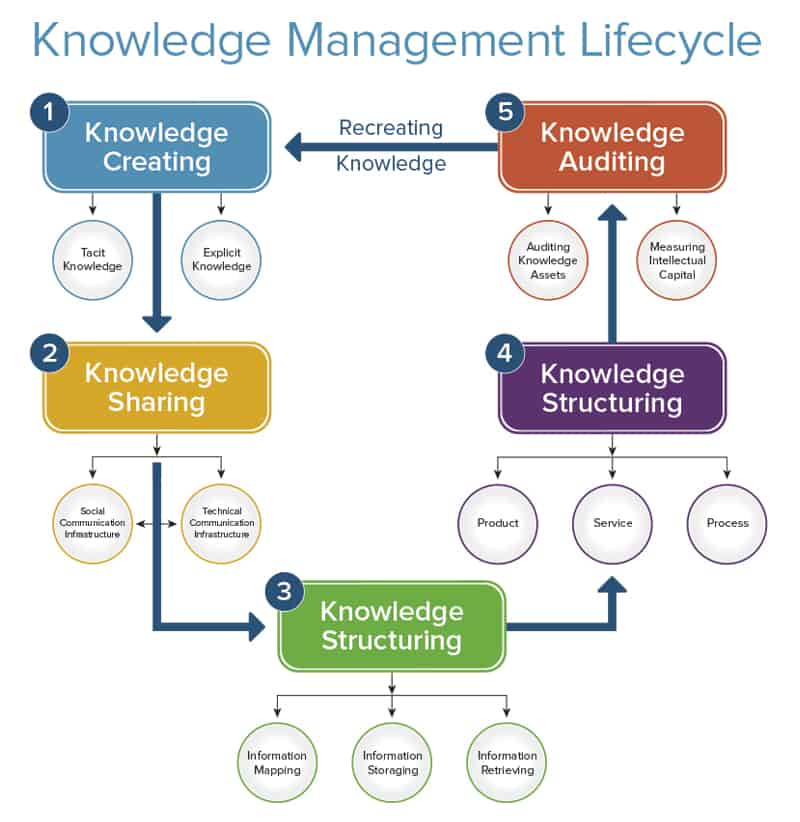
While each life cycle differs in specific steps, this infographic shows the basic steps.
There are multiple, semi-competing theories of the knowledge management life cycle. However, despite the nuanced theoretical and syntactical differences, the top four all follow a similar pattern. Here are the top four KM life cycle models:
- Wiig Model (1993): This model relies on the principle that in order for information to be useful, it must be organized. Therefore, this model is primarily concerned with organizing all data once it is codified, but also outlines how knowledge is built, stored, pooled (with other stored knowledge), and then extended into the organization. The phases of the Wiig model are creation, sourcing, compilation, transformation, and application.
- Zack Model (1996): While the phases here are similar to the Wiig model, the Zack model prioritizes a logical, standardized process when advancing to each new stage. The phases of the Zack model are acquisition, refinement, storage/retrieval, distribution, and presentation.
- Bukowitz and William Model (2000): This model builds upon the previous two by expanding the definition of knowledge storage to include the infrastructure that supports this learning community (such as communication, hierarchy, and working relationships). Bukowitz and William also emphasize the need for not only maintaining your knowledge repository, but also building it over time. The phases here are: get, use, learn, contribute, and assess.
- McElroy Model (2003): Building upon the process focus of the Bukowitz and William model, McElroy is concerned with knowledge production and integration. It creates ways for team members to submit “claims” when they fail to receive or understand knowledge, all in an effort to improve group learning. The phases in the McElroy model are learning, validation, acquisition, integration, and completion.
Here’s how all the different phases of these model relate to each other:
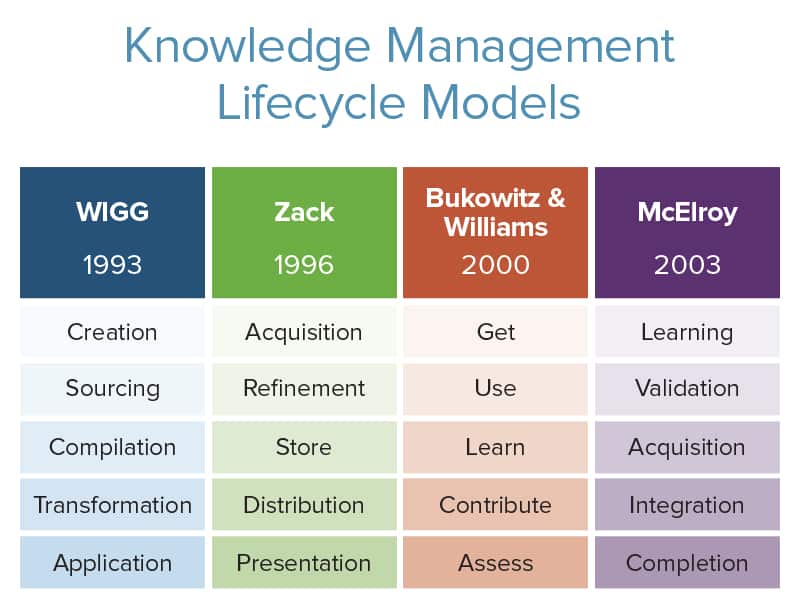
The integrated knowledge management cycle, proposed by Kimiz Dalkir, Ph.D., combines several of the concepts we’ve discussed into one general framework. Dalkir identifies three key stages in her model: knowledge capture and/or creation, knowledge sharing and dissemination, and knowledge acquisition and application. In this model, Dalkir emphasizes the cycle aspect in order to ensure continual improvement - not only in the amount and quality of knowledge stored, but of the underlying processes, as well
How to Improve Knowledge Management
Even with an understanding of the KM life cycle, knowledge management can be difficult to implement. Below are a few tips on how to improve knowledge management:
- Understand the flow of knowledge in your organization: While the various KM life cycle models list phases to follow, they are merely a blueprint. Knowledge management will only be successful if you understand how your organization already naturally gains, stores, and shares knowledge, so use the existing flow of information to structure your formal knowledge management process.
- Clearly define your goals and how you will measure them: Just like any project, you won’t be able to judge your success without clearly defined goals. Choose objectives and how you will measure them before you implement KM.
- Encourage socialization: One way to foster an environment of knowledge transfer is to let it happen naturally, by talking and casually sharing. Allow team members to talk and form relationships in-office, which will make them more likely to turn to each other for information or advice, or to learn new skills.
- Generate new knowledge: Remember that knowledge management is not only concerned with storing existing knowledge; rather, you need to create processes to manage the ongoing stream of new information. Actively generate new knowledge within your organization not only to create a robust knowledge stream, but also to show your employees that you treat new knowledge - and their knowledge - as an asset. This will make workers more apt to adopt KM.
- Employ technology: Technology can play a huge role in standardizing and organizing the KM process. However, remember that technology itself is not knowledge management, but simply a tool to enhance your processes. We’ll discuss knowledge management technology in depth in the next section.
What Is a Knowledge Management System?
A knowledge management system is any technology that is used to store and manage knowledge - essentially, a tool to oversee knowledge management. However, a successful knowledge management system also taps into the underlying goals of KM: codifying knowledge, retrieving knowledge, improving collaboration, and stimulating overall organizational learning.
Knowledge management systems have evolved from a useful tool to optimize KM processes to an integral component of KM itself. Today, organizations rely on KM systems to perform many of the functions of knowledge management - data storage is an obvious example, but technology systems can also help foster collaboration and group learning, among other objectives.
There are several emerging features in contemporary knowledge management systems. Here’s a look at some of the most prominent ones:
- Content and document management: This is a critical component because codifying knowledge almost always results in documentation (or another form of created content). When choosing a KM system, make sure the platform can support the file size, type(s), and volume that you need. This is especially important for enterprise companies who will need to store massive amounts of data, and scale regularly. (For this functionality, look for enterprise portals.)
- Lessons learned databases: These are systems that aim to make intangible (often tacit) knowledge clear and available to other users. The focus with lessons learned databases is as the name implies: on lessons learned by experts that others should follow (think of it as best practices). The key here is to find a database that can house this kind of qualitative information and make it accessible.
- Groupware: As we’ve discussed, collaboration is a key component of KM. Groupware refers to any collaborative work platform, and is usually intended for workers who need to communicate remotely. Groupware is broken down into two categories: synchronous groupware (collaborate and update in real time) and asynchronous groupware.
- Artificial Intelligence (AI): The adoption of AI (as telepresence) into KM systems replaces the human consultants that had been analyzing the data and monitoring the KM processes. Today, cognitive computing, adaptive technology, and intelligent filtering tools, in particular, have huge implications for codifying knowledge, and will likely be adopted by more KM systems. However, the importance of human quality assurance (QA) in much of today’s data work has raised concerns about AI’s ability to fully take over this space.
Although KM systems can help automate and standardize knowledge management, there are several challenges when implementing a system. Security, data accuracy, and changes in technology (cost, implementation, usability) are focused difficulties that you should keep in mind from the get-go. A much more pervasive and ongoing challenge, however, is creating a culture of collaboration and knowledge sharing via technology. People may already be reluctant to share information with their peers, and technology can create even more barriers for doing so. Therefore, you’ll need to build in processes that support and stimulate this type of knowledge transfer.
Kevin Murray offers four key things to look for when choosing a KM system:
- Security: Information is valuable. Like any other valuable, there are people who will steal it.
- Accountability: Information is valuable only when it is accurate. Limit access. Log intensively. Test for accuracy.
- Backup: Everyone knows the value of backing up. Not everyone knows how to do it. Hiding a backup drive in the CEO's desk won't help if the building floods or burns. Creating, maintaining, and correctly storing back-ups should be an automatic functionality.
- Ease of Use: If the system is too difficult or demanding to use, people will take shortcuts. Shortcuts usually reduce security and the integrity of the information you're managing.
When discussing the future of KM systems, many critics claim that knowledge management itself is a fad. However, others think that KM and KM systems will simply evolve to meet the demands of today’s business world - likely incorporating more AI-driven systems. Murray agrees with the latter camp.
“It's no fad. It's an imperative. The amount of information being created grows each year. It has to be managed, if you want it to be useful,” he says. “KM systems will continue to increase in popularity, functionality, and ease-of-use, just like the evolution of typewriters and word processing software. Artificial Intelligence (AI) will blend into the mix even more.”
A Collaborative Knowledge Management System With Smartsheet
Empower your people to go above and beyond with a flexible platform designed to match the needs of your team — and adapt as those needs change.
The Smartsheet platform makes it easy to plan, capture, manage, and report on work from anywhere, helping your team be more effective and get more done. Report on key metrics and get real-time visibility into work as it happens with roll-up reports, dashboards, and automated workflows built to keep your team connected and informed.
When teams have clarity into the work getting done, there’s no telling how much more they can accomplish in the same amount of time. Try Smartsheet for free, today.
Discover why over 90% of Fortune 100 companies trust Smartsheet to get work done.

Knowledge management (KM) is the process of identifying, organizing, storing and disseminating information within an organization.
When knowledge is not easily accessible within an organization, it can be incredibly costly to a business as valuable time is spent seeking out relevant information versus completing outcome-focused tasks.
A knowledge management system (KMS) harnesses the collective knowledge of the organization, leading to better operational efficiencies. These systems are supported by the use of a knowledge base. They are usually critical to successful knowledge management, providing a centralized place to store information and access it readily.
Companies with a knowledge management strategy achieve business outcomes more quickly as increased organizational learning and collaboration among team members facilitates faster decision-making across the business. It also streamlines more organizational processes, such as training and on-boarding, leading to reports of higher employee satisfaction and retention.
Use this model selection framework to choose the most appropriate model while balancing your performance requirements with cost, risks and deployment needs.
Register for the ebook on generative AI
The definition of knowledge management also includes three types of knowledge—tacit, implicit, and explicit knowledge. These types of knowledge are largely distinguished by the codification of the information.
- Tacit knowledge: This type of knowledge is typically acquired through experience, and it is intuitively understood. As a result, it is challenging to articulate and codify, making it difficult to transfer this information to other individuals. Examples of tacit knowledge can include language, facial recognition, or leadership skills.
- Implicit knowledge: While some literature equivocates implicit knowledge to tacit knowledge, some academics break out this type separately, expressing that the definition of tactic knowledge is more nuanced. While tacit knowledge is difficult to codify, implicit knowledge does not necessarily have this problem. Instead, implicit information has yet to be documented. It tends to exist within processes, and it can be referred to as “know-how” knowledge.
- Explicit knowledge: Explicit knowledge is captured within various document types such as manuals, reports, and guides, allowing organizations to easily share knowledge across teams. This type of knowledge is perhaps the most well-known and examples of it include knowledge assets such as databases, white papers, and case studies. This form of knowledge is important to retain intellectual capital within an organization as well as facilitate successful knowledge transfer to new employees.
While some academics (link resides outside ibm.com) summarize the knowledge management process as involving knowledge acquisition, creation, refinement, storage, transfer, sharing and utilization. This process can be synthesized this a little further. Effective knowledge management system typically goes through three main steps:
- Knowledge Creation: During this step, organizations identify and document any existing or new knowledge that they want to circulate across the company.
- Knowledge Storage: During this stage, an information technology system is typically used to host organizational knowledge for distribution. Information may need to be formatted in a particular way to meet the requirements of that repository.
- Knowledge Sharing: In this final stage, processes to share knowledge are communicated broadly across the organization. The rate in which information spreads will vary depending on organizational culture. Companies that encourage and reward this behavior will certainly have a competitive advantage over other ones in their industry.
There are a number tools that organizations utilize to reap the benefits of knowledge management. Examples of knowledge management systems can include:
- Document management systems act as a centralized storage system for digital documents, such as PDFs, images, and word processing files. These systems enhance employee workflows by enabling easy retrieval of documents, such as lessons learned.
- Content management systems (CMS) are applications which manage web content where end users can edit and publish content. These are commonly confused with document management systems, but CMSs can support other media types, such as audio and video.
- Intranets are private networks that exist solely within an organization, which enable the sharing of enablement, tools, and processes within internal stakeholders. While they can be time-consuming and costly to maintain, they provide a number of groupware services, such as internal directories and search, which facilitate collaboration.
- Wikis can be a popular knowledge management tool given its ease of use. They make it easy to upload and edit information, but this ease can lead to concerns about misinformation as workers may update them with incorrect or outdated information.
- Data warehouses aggregate data from different sources into a single, central, consistent data store to support data analysis, data mining, artificial intelligence (AI), and machine learning. Data is extracted from these repositories so that companies can derive insights, empowering employees to make data-driven decisions.
While knowledge management solutions can be helpful in facilitating knowledge transfer across teams and individuals, they also depend on user adoption to generate positive outcomes. As a result, organizations should not minimize the value of human elements that enable success around knowledge management.
- Organizational Culture: Management practices will affect the type of organization that executives lead. Managers can build learning organizations by rewarding and encouraging knowledge sharing behaviors across their teams. This type of leadership sets the groundwork for teams to trust each other and communicate more openly to achieve business outcomes.
- Communities of practice: Centers of excellence in specific disciplines provide employees with a forum to ask questions, facilitating learning and knowledge transfer. In this way, organizations increase the number of subject matter experts in a given area of the company, reducing dependencies on specific individuals to execute certain tasks.
Armed with the right tools and strategies, knowledge management practices have seen success in specific applications, such as:
- Onboarding employees: Knowledge management systems help to address the huge learning curve for new hires. Instead of overwhelming new hires with a ‘data dump’ in their first weeks, continually support them with knowledge tools that will give them useful information at any time. Learn more
- Day-to-day employee tasks: Enable every employee to have access to accurate answers and critical information. Access to highly relevant answers at the right time, for the right person, allows workforces to spend less time looking for information and more time on activities that drive business. Learn more
- Self-serve customer service: Customers repeatedly say they’d prefer to find an answer themselves, rather than pick up the phone to call support. When done well, a knowledge management system helps businesses decrease customer support costs and increase customer satisfaction. Learn more
Companies experience a number of benefits when they embrace knowledge management strategies. Some key advantages include:
- Identification of skill gaps: When teams create relevant documentation around implicit or tacit knowledge or consolidate explicit knowledge, it can highlight gaps in core competencies across teams. This provides valuable information to management to form new organizational structures or hire additional resources.
- Make better informed decisions: Knowledge management systems arm individuals and departments with knowledge. By improving accessibility to current and historical enterprise knowledge, your teams can upskill and make more information-driven decisions that support business goals.
- Maintains enterprise knowledge: If your most knowledgeable employees left tomorrow, what would your business do? Practicing internal knowledge management enables businesses to create an organizational memory. Knowledge held by your long-term employees and other experts, then make it accessible to your wider team.
- Operational efficiencies: Knowledge management systems create a go-to place that enable knowledge workers to find relevant information more quickly. This, in turn, reduces the amount of time on research, leading to faster decision-making and cost-savings through operational efficiencies. Increase productivity not only saves time, but also reduces costs.
- Increased collaboration and communication: Knowledge management systems and organizational cultures work together to build trust among team members. These information systems provide more transparency among workers, creating more understanding and alignment around common goals. Engaged leadership and open communication create an environment for teams to embrace innovation and feedback.
- Data Security: Knowledge management systems enable organizations to customize permission control, viewership control and the level of document-security to ensure that information is shared only in the correct channels or with selected individuals. Give your employees the autonomy access knowledge safely and with confidence.
Experiment with foundation models and build machine learning models automatically in our next-generation studio for AI builders.
Watson Discovery is an award-winning AI-powered search technology that eliminates data silos and retrieves information buried inside enterprise data.
How to drive your DataOps framework with a single layer of business knowledge that supports self-service, data governance, AI, natural language processing, and accelerated data lake generation.
Train, validate, tune and deploy generative AI, foundation models and machine learning capabilities with IBM watsonx.ai, a next-generation enterprise studio for AI builders. Build AI applications in a fraction of the time with a fraction of the data.
Newly Launched - AI Presentation Maker

Researched by Consultants from Top-Tier Management Companies

Powerpoint Templates
Icon Bundle
Kpi Dashboard
Professional
Business Plans
Swot Analysis
Gantt Chart
Business Proposal
Marketing Plan
Project Management
Business Case
Business Model
Cyber Security
Business PPT
Digital Marketing
Digital Transformation
Human Resources
Product Management
Artificial Intelligence
Company Profile
Acknowledgement PPT
PPT Presentation
Reports Brochures
One Page Pitch
Interview PPT
All Categories
Top 5 Knowledge Management Process Templates with Samples and Examples

Let's imagine a world where information is absorbed and transferred across groups without friction. In this perfect world, businesses will prosper, new ideas will flourish, and achievements will be the norm. So how can we make this hope a reality?
According to the great philosopher Francis Bacon: “Knowledge is power, but only if it is organized and shared.”
Motivated by this wise quote, we begin an exciting quest to uncover the five most effective knowledge management process templates and show how they can transform how firms gather, organize, and disseminate information.
The knowledge lifecycle is explored, and you're invited to explore it with us by exploring a wealth of knowledge management templates tailored to different stages. These templates from SlideTeam cover the entire knowledge sharing management process, from generating new information to sharing it with others. Let's look at each of the Top 5 Knowlsdge Management Process Templates that have revolutionized businesses everywhere.
Template 1: Knowledge Management Process, Including Improvement
Picture a busy advertising firm always looking to adapt to the changing digital scene. They need a way to organize massive volumes of data to refine their tactics over time. Here is where this template comes in as a savior.
Their efforts in knowledge management are set against a beautiful setting given by these slides. The eight-step method presented in the slides best provides any knowledge organization with a roadmap to success. It includes enhancement, technology, people, process, counsel, insights, data, and exercise.
You can easily automate routine tasks, encourage knowledge sharing among employees, and make better strategic decisions based on data. Get them today and start your road to greater success and productivity.

DOWNLOAD NOW
Template 2: Knowledge Management Processes, Including Storage
"Knowledge is like a treasure, waiting to be captured and stored for future use." This insight completely fulfils this essence and need of these high-end templates. For continued success in today's fast-paced corporate environment, efficient knowledge storage is essential. This is when this template comes in handy.
These slides provide a thorough guide to improving knowledge management with a six-step method, including knowledge collection and creation, capture, organization, storage, sharing, and application. The templates are a great way to create an impression on your audience because of their eye-catching design and adaptability. Businesses can use these to improve their processes for gathering information, storing, and retrieving information, collaborating across departments, and fostering innovation and growth. Start your path toward better knowledge management and long-term success by downloading it now.

Template 3: Quarterly Roadmap for Knowledge Management Process Strategy
There is no doubt having a clear strategy is essential in today's fast-paced corporate environment. Here is where this eye-catching template is perfect for drawing people in.
This fully-editable roadmap style is perfect for presenting your knowledge management plan, thanks to its hierarchical shape and color-coded design. Rather than burying your team in paperwork, you can now quickly and clearly outline expectations and explain how various tasks go together.
This plan makes assigning team members to tasks and milestones within a certain period possible. The adaptability of this template will enable you to adjust your approach in response to changing circumstances. Get it today, use it to spark your company's knowledge capture management process, and launch to greater success.

Template 4: Service Desk Knowledge Management Process Flow Service Desk Management to Enhance
Are you ready to take your service desk management to new heights? Unlock the power of knowledge with this PPT Template. This engaging slide provides a comprehensive overview of the process flow, answering key questions such as: How do you identify knowledge gaps? How do you write and revise articles? How do you publish and evaluate them?
With this template, you can deliver an outstanding presentation, dispense vital information, and thoroughly explain service desk management and knowledge management. The best part? This template is fully customizable to fit your unique needs, ensuring a personalized and impactful presentation. Take advantage of the opportunity to enhance your service desk management. Download the template now and get ready to empower the power of knowledge application .

Template 5: Knowledge Management Process Model PPT
A competent and skilled staff is essential in today's fast-paced corporate environment. Don't you think? Now you need to feel relaxed if you struggle to find the same. Wondering how? With this next-gen template.
This premium PPT template has slides so you may explain a wide range of business processes, from data collecting and analysis to content production and distribution to Knowledge acquisition and generation . Use this presentation template for content management in business to create a splash and break all kinds of records.
This process optimization template can equip you to make any presentation easily. Put an end to the hurdles and demonstrate your skills. Get it today and see your presentations transform!

Unlock Knowledge Doors for Your Business Growth!
Come along on this exciting adventure with the top five knowledge management process templates above. They are the key to a universe in which information is paramount. These knowledge management templates and social management crises templates can be easily implemented with SlideTeam, ushering in a new era of efficiency and creativity for businesses.
FAQs on the Knowledge Management Process
What are the 4 processes of knowledge management.
Knowledge management consists of four main phases, which are as follows:
- Acquisition: The term "acquisition" refers to locating and acquiring information from internal and external sources.
- Creation: Knowledge generation is turning existing information into useful new knowledge. Innovation is coming up with fresh ideas and learning something new.
- Storage: Once gained or developed, knowledge must be kept in a way that makes it easy to retrieve later. To achieve this goal, it is necessary to classify and catalogue information and establish knowledge management systems.
- Dissemination: The dissemination process aims to ensure that the company benefits from the information being shared.
What are the 5 steps of the knowledge management process?
The steps are as follows:
- Capture: Knowledge is "captured" by finding relevant sources and collecting that information for later use. This method includes documentation, interviews, surveys, and in-depth observations.
- Organize: The next step, organization, is essential for making information that has been recorded accessible and usable. The information must be organized, categorized, and structured to be useful and understandable to the intended audience.
- Storage: Putting information away safely assures that it will always be accessible. The next step is to select a suitable way of storing the knowledge assets, such as a database, knowledge repository, or content management system.
- Share: Learn and work together effectively by sharing what you know. In this stage, we'll work on improving the flow of information between people, groups, and divisions.
- Apply: The next stage is to put what you've learned into practice to spur creativity and boost efficiency. You are solving issues, making well-informed choices, and enhancing processes and practices required using the information gathered and shared.
What are the 8 stages of the knowledge management process?
- Acquisition: Knowledge management involves acquisition and creation, capture, organization, storage, sharing, transfer, application, and retention.
- Acquisition and generation: Knowledge is gained from internal and external sources. Research, market analysis, consumer feedback, and brainstorming may develop new knowledge.
- Capture: This step includes documentation, interviews, and expert knowledge extraction. To store explicit and implicit information.
- Organization: To retrieve knowledge, it must be arranged. This stage organizes knowledge using taxonomies, metadata, and other categorization approaches.
- Storage: Knowledge must be safe and accessible. Selecting databases, knowledge repositories, or content management systems is this step.
- Collaboration and learning need knowledge exchange: This stage helps people, teams, and departments share information via numerous communication methods.
- Transfer: Transferring knowledge across people or departments. It may include mentorship, training, or knowledge transfer to ensure knowledge retention.
- Application: Applying knowledge to solve issues, make choices, and enhance processes. Applying knowledge to real-world problems drives innovation and organizational effectiveness.
- Retention: The last step retains organizational information. Knowledge retention, recordkeeping, and succession planning are included.
What are the seven knowledge management life cycles?
- Identification: Identifying a problem, writing it down, filing it away, searching for it later, sharing it with others, and finally using it are the seven steps in the knowledge management life cycle.
- Capture: During this phase, information is gathered by procedures including documentation, interviews, and knowledge extraction from internal and external sources.
- Organization: Categorization, taxonomy, and metadata arrange the collected information for simple retrieval and use.
- Storage: Information is archived for the long term in suitable repositories or systems like databases, knowledge bases, or content management systems.
- Retrieval: Thanks to efficient search and retrieval systems, users may quickly and easily discover the information they need.
- Dissemination: Knowledge is communicated to those who may benefit from it via formal training programs, internal networks, and online collaborative spaces.
- Implementation: Putting what you've learned into practice is the last step, and it's where you'll find the greatest gains in efficiency and effectiveness for yourself and your business.
Related posts:
- Top 10 Business Process Management Templates with Samples and Examples
- Top 10 Project Management Templates with Samples and Examples
- [Updated 2023] Top 30 Product Management PowerPoint Templates for Every Product Manager
- Top 10 Property Management Templates with Samples and Examples (Free PDF Attached)
Liked this blog? Please recommend us

Top 10 Product Branding Templates with Examples and Samples

Top 10 Slides to Create Photography Business Plan- Free PPT & PDF
This form is protected by reCAPTCHA - the Google Privacy Policy and Terms of Service apply.

--> Digital revolution powerpoint presentation slides

--> Sales funnel results presentation layouts
--> 3d men joinning circular jigsaw puzzles ppt graphics icons

--> Business Strategic Planning Template For Organizations Powerpoint Presentation Slides

--> Future plan powerpoint template slide

--> Project Management Team Powerpoint Presentation Slides

--> Brand marketing powerpoint presentation slides

--> Launching a new service powerpoint presentation with slides go to market

--> Agenda powerpoint slide show

--> Four key metrics donut chart with percentage

--> Engineering and technology ppt inspiration example introduction continuous process improvement

--> Meet our team representing in circular format


- My presentations
Auth with social network:
Download presentation
We think you have liked this presentation. If you wish to download it, please recommend it to your friends in any social system. Share buttons are a little bit lower. Thank you!
Presentation is loading. Please wait.
Knowledge Management Systems
Published by 문의 도 Modified over 5 years ago
Similar presentations
Presentation on theme: "Knowledge Management Systems"— Presentation transcript:

HR SCORECARD Presented By ADEEL TARIQ MOBASHIR ALI.

Introduction to research. Topics to be discussed What is research? Why managers should know about research? Business research. Types of business.

Managing Knowledge in the Digital Firm (II) Soetam Rizky.

Knowledge Management The nature of KM A process model for KM KM and KE.

Managing in a Global Context

Knowledge Management Goals of KM Knowledge Management is the planning, organizing, motivating, and controlling of people, processes, and systems within.

Human Resource Champions: The Next Agenda for Adding Value and Delivering Results Presented by Ivan Chang.

Basic Characteristics of Organizational Structure Division of labor: dividing up the many tasks of the organization into specialized jobs Hierarchy of.

KNOWLEDGE MANAGEMENT AT ACCENTURE

Copyright 2002 Prentice-Hall, Inc. Chapter 1 The Systems Development Environment 1.1 Modern Systems Analysis and Design Third Edition Jeffrey A. Hoffer.

1 Knowledge Management. 2 Knowledge management (KM) is a process that helps organizations identify, select, organize, disseminate, and transfer important.

Chapter 9 Knowledge Management.

KNOWLEDGE MANAGEMENT Knowledge Hierarchy Categories of Knowledge

Feasibility Analysis Chapter 3

Copyright South-Western College Publishing Leadership by Human Resources Organizational Roles and Choices.

© Ali Nasir Management Information Systems (MIS) Management Information Systems (MIS) Lecture 1: Introduction Muhammad Ali Nasir Fall-2010.

Company X Knowledge Management by John Millies Olaitan Asekun Sandra Hernandez Anabel Castorena.

14-1 Chapter 14 Managing Knowledge Applying Innovation By David O’Sullivan and Lawrence Dooley © Sage Publications 2008.

Forethought Knowledge is our most important engine of production – Alfred Marshal Knowledge is the key resource of the 21st century Problem today is.

Module 3: Business Information Systems Chapter 11: Knowledge Management.
About project
© 2024 SlidePlayer.com Inc. All rights reserved.
The Complete Guide to Knowledge Management

Knowledge management is the process of capturing, distributing, and effectively using organizational knowledge to drive business success.
When done right, it can lead to impressive results. One study found that companies with effective knowledge management practices see a 5-10% increase in productivity and a 10-15% reduction in costs.
In this ultimate guide, we’ll dive into what knowledge management is, its benefits, best practices, and the tools to make it happen. Get ready to unlock your organization’s full potential.
In this section, we’ll explore how to effectively implement knowledge management to boost organizational efficiency. First, it’s vital to establish a clear strategy . Without a plan, efforts can become scattered and ineffective. I start by defining the goals and objectives. What do we want to achieve? Increased productivity? Better decision-making?
Next, I focus on technology. Choosing the right tools is important. I look for user-friendly software that facilitates easy access and sharing of information. Integrating these tools into daily operations guarantees that knowledge flows seamlessly across the organization.
Creating a culture of sharing is another pivotal step. I encourage open communication and collaboration by setting the example. If people see me sharing knowledge freely, they’re more likely to do the same. Incentives can also help motivate employees to contribute.
I also prioritize training. It’s not enough to have systems in place; everyone needs to know how to use them effectively. Regular workshops and training sessions can bridge this gap.
What is Knowledge Management?
Understanding knowledge management starts with recognizing it as a strategic process that involves capturing , distributing , and effectively using organizational knowledge . When I think about knowledge management, I see it as the backbone of an organization’s ability to innovate, adapt, and remain competitive. It’s not just about storing information ; it’s about guaranteeing that the right knowledge reaches the right people at the right time.
In my experience, successful knowledge management hinges on a few key elements. First, there’s capturing knowledge, which can come from various sources like documents, databases, and employees’ expertise. Then, distributing this knowledge effectively ensures that everyone in the organization can access and use it when needed. This often involves creating systems and processes that facilitate easy sharing and retrieval of information.
Another critical aspect is making certain that the knowledge is used effectively. This means fostering a culture where employees value and apply shared knowledge in their daily tasks and decision-making processes . I’ve seen organizations thrive when they prioritize continuous learning and encourage collaboration across departments.
Ultimately, knowledge management is about leveraging collective intelligence to drive better outcomes and sustainable growth .
Types of Knowledge Management
When we discuss types of knowledge management, we need to take into account explicit , implicit , and tacit knowledge. Each type plays a unique role in how information is shared and utilized within an organization.
Let’s explore how these different forms of knowledge impact our approaches to managing information.
Explicit Knowledge
Explicit knowledge, which can be easily documented and shared, forms the backbone of any effective knowledge management system. When I think about explicit knowledge, I’m reminded of all the tangible resources that teams and organizations rely on daily. This includes things like manuals, guidelines , databases , and reports. These resources are invaluable because they provide clear, accessible information that anyone in the organization can reference.
One of the key advantages of explicit knowledge is that it’s relatively easy to store and retrieve. When I need to onboard new employees or maintain consistency across projects, having well-documented procedures and best practices makes a world of difference. Explicit knowledge can be digitized and organized in such a way that it’s searchable, making it simple for team members to find the information they need quickly.
Moreover, explicit knowledge isn’t just about storing information; it’s about guaranteeing that knowledge is transferred effectively. By creating a centralized repository of documents and resources, I can cultivate a culture of shared understanding and continuous improvement. This repository becomes a living library that evolves as new insights are gained and old information is updated, ensuring that everyone remains on the same page.
Implicit knowledge
Implicit knowledge, often referred to as tacit knowledge, encompasses the skills, experiences, and insights that individuals carry within them but find difficult to articulate or document.
As I reflect on my own experiences, I realize that much of what I know and do comes from this implicit knowledge. It’s the know-how I’ve gained through years of practice, like riding a bike or developing a knack for creative problem-solving.
One of the biggest challenges with implicit knowledge is that it’s not easily transferable. Unlike explicit knowledge, which can be written down or shared in a manual, implicit knowledge often requires direct interaction or demonstration.
Here are three ways to better manage and harness implicit knowledge:
- Mentorship Programs : Pairing less experienced employees with seasoned mentors can facilitate the transfer of implicit knowledge through observation and practice.
- Communities of Practice : Creating groups where individuals with similar roles or interests can regularly meet and share their experiences fosters an environment where implicit knowledge can flow more freely.
- Storytelling Sessions : Encouraging team members to share stories about their work experiences can uncover valuable insights and lessons that aren’t captured in formal documents.
Tacit knowledge
Tacit knowledge, unlike explicit knowledge , resides in the minds of individuals and is often demonstrated through actions and behaviors rather than written instructions. It’s the kind of knowledge that’s tough to access because it’s deeply personal and context-specific.
When I think about tacit knowledge , I think about skills like riding a bike or playing a musical instrument . You can read all the manuals you want, but until you actually get on the bike or pick up the instrument, you won’t truly understand how to do it.
In my experience, tacit knowledge is often shared through mentoring , observation , and hands-on practice . For example, a seasoned chef might teach an apprentice by showing them how to feel when the dough is just right, something that can’t be fully captured in a recipe.
The challenge with managing tacit knowledge is that it requires a more nuanced approach than just documenting processes. It demands creating environments where people can share experiences and learn through doing.
To tap into this valuable asset, I’ve found that fostering a culture of collaboration and continuous learning is key. Encouraging open communication and building strong relationships within teams helps access the wealth of tacit knowledge that individuals hold.
Benefits of a knowledge management system
A well-implemented knowledge management system can greatly enhance productivity by streamlining access to important information. When I’ve a centralized repository for all relevant data, it reduces the time spent searching for documents or guidelines. This streamlined access means I can focus more on my core tasks and less on administrative overhead.
One of the biggest benefits I’ve noticed is improved collaboration. When everyone has access to the same information, we can work together more effectively, avoiding miscommunication and redundant efforts. This leads to faster problem-solving and more innovative solutions.
Another significant advantage is the retention of organizational knowledge. Employees come and go, but a well-maintained knowledge management system secures that their insights and expertise remain within the organization. This continuous accumulation of knowledge helps in training new employees and maintaining consistency in operations.
Here are three key benefits of a knowledge management system:
- Increased Efficiency : Quick access to information reduces downtime and accelerates decision-making processes.
- Enhanced Collaboration : Shared knowledge fosters teamwork and minimizes duplication of efforts.
- Knowledge Retention : Capturing and preserving valuable insights secures continuity and aids in onboarding new team members efficiently.
Knowledge Management Use Cases
When I think about knowledge management use cases, several key areas come to mind.
It’s essential for employee and product onboarding , enhancing team communication, and improving customer support from both the agent’s and customer’s perspectives.
These use cases show how a well-implemented system can streamline processes and boost efficiency.
Employee Onboarding
Effective employee onboarding is essential for integrating new hires seamlessly into the organization and maximizing their productivity from day one. When I think about the role of knowledge management in this process, it’s evident that having a structured and accessible repository of information is vital.
Here’s how knowledge management can enhance the onboarding experience:
- Centralized Information Repository : New employees benefit immensely from having a go-to place for all essential documents, guidelines, and FAQs. It eliminates confusion and guarantees everyone has access to the same updated information.
- Interactive Training Modules : Incorporating interactive and engaging training modules within the knowledge management system helps new hires learn at their own pace. This approach not only makes training more effective but also more enjoyable.
- Mentorship and Social Learning : Knowledge management platforms can facilitate connections between new hires and experienced employees. Through discussion forums and mentorship programs, new employees can ask questions, share ideas, and learn from their peers.
Product Onboarding
Harnessing knowledge management during product onboarding guarantees that all team members swiftly become proficient with new tools and processes. When I introduce a new product, I make certain that our knowledge base is up-to-date with all relevant information, tutorials, and FAQs. This centralized repository allows everyone to access the same high-quality resources , reducing the time it takes to get up to speed.
I’ve found that integrating knowledge management systems with our onboarding process greatly reduces confusion and errors. For instance, detailed guides and step-by-step instructions are readily available, minimizing the need for constant back-and-forth with more experienced team members. Additionally, having a well-organized knowledge base fosters a culture of self-sufficiency and continuous learning.
One of the most effective strategies I use is incorporating feedback loops . As team members go through the onboarding process, they can contribute insights and suggest improvements to the existing documentation. This not only enhances the quality of the knowledge base but also creates a sense of ownership and collaboration.

Team Communication
A robust knowledge management system transforms team communication by providing easy access to essential information and facilitating seamless collaboration. I’ve seen firsthand how having a centralized repository of knowledge can break down silos and make it easier for team members to share insights and updates. When everyone has access to the same information, it eliminates miscommunication and guarantees that the team is aligned and working towards common goals.
Here are three ways a knowledge management system enhances team communication:
- Centralized Information Hub : By storing all documents, guidelines, and project updates in one place, it guarantees everyone is on the same page. No more digging through emails or asking around for the latest version of a file.
- Real-Time Collaboration : Features like document sharing, commenting, and version control make it easy for team members to work together, even if they’re in different locations or time zones. This fosters a more dynamic and responsive work environment.
- Improved Onboarding : New team members can quickly get up to speed by accessing a well-organized knowledge base. This reduces the learning curve and helps them integrate into the team more smoothly.
Customer Support (Agent’s Perspective)
Building on the benefits of knowledge management for team communication, let’s explore how it empowers customer support agents to deliver exceptional service. When I’m handling multiple customer queries, having a centralized knowledge base at my fingertips is a game-changer. It allows me to quickly find accurate information, ensuring that I provide consistent and reliable answers to customers.
This accessibility means I spend less time searching for solutions and more time actually helping customers. It also reduces my stress levels because I know I’m well-equipped to handle a wide range of issues. Knowledge management systems often come with search functionalities and categorizations that streamline my workflow , making it easier to navigate complex information.
Moreover, these systems enable me to document new solutions and share them with my team. This collective intelligence not only enhances individual performance but also elevates the overall efficiency of the support team. When new agents join, they can quickly ramp up by accessing the accumulated knowledge, reducing training time and accelerating their productivity.
In essence, knowledge management transforms my role from merely reactive to proactively providing exceptional customer service , making my job more satisfying and effective.
Self-Service (Customer’s Perspective)
From a customer’s perspective, having access to a well-structured knowledge base empowers me to find answers independently and quickly. When I encounter a problem or have a question about a product or service, I don’t want to wait on hold or sift through endless forums. Instead, I prefer to consult a reliable source where I can get accurate information fast.
Self-service options offer several clear advantages:
- Efficiency : I can resolve issues at my own pace without relying on customer service agents. This saves time for both me and the company.
- 24/7 Availability : Unlike traditional support channels, a knowledge base is always accessible. Whether it’s midnight or a holiday, I can find the help I need.
- Empowerment : Having the tools to solve my own problems boosts my confidence and satisfaction. I appreciate companies that trust me to handle certain issues myself.
These benefits make a strong case for businesses to invest in thorough, user-friendly knowledge management systems. When done right, these systems enhance user experience and reduce the strain on customer support teams. In turn, this creates a win-win situation for both customers and companies.
Knowledge Management Tools
Effective knowledge management hinges on utilizing the right tools to capture, store, and share information seamlessly. I’ve found that diverse tools cater to various aspects of knowledge management, each offering unique benefits.
For instance, content management systems (CMS) like WordPress help organize and manage digital content efficiently. They’re great for maintaining a repository of articles, documents, and multimedia files that can be easily updated and accessed.
Collaboration platforms such as Microsoft Teams or Slack are indispensable for real-time communication and project management . They allow team members to share insights, documents, and updates instantly. These tools greatly enhance collective knowledge sharing and foster a collaborative work environment.
I also rely on document management systems (DMS) like Google Drive or Dropbox for secure and accessible file storage . These systems ensure that important documents aren’t only safely stored but also easily retrievable whenever needed.
Moreover, mind mapping tools like MindMeister can help in brainstorming and visually organizing ideas . They’re excellent for breaking down complex information into digestible parts, making it easier to understand and share.
Incorporating these varied tools into my knowledge management strategy has been instrumental in maintaining a well-organized , efficient, and collaborative workspace .
Knowledge Base Software
While tools like CMS and collaboration platforms play a significant role, I’ve found that knowledge base software is equally vital for creating a centralized repository of information. This type of software helps organize, manage, and retrieve knowledge efficiently. It guarantees that everyone in an organization can access the information they need when they need it.
One of the key benefits of using knowledge base software is its ability to streamline information dissemination. Instead of sifting through countless emails or documents, employees can quickly find the answers they need. Additionally, it enhances collaboration by allowing multiple users to contribute and update content.
Here’s why I believe investing in knowledge base software is essential:
- Improved Efficiency : Employees spend less time searching for information, leading to increased productivity.
- Consistent Information : A centralized knowledge base ensures that everyone has access to the most up-to-date information, reducing errors and miscommunication.
- Enhanced Learning : New employees can get up to speed faster by accessing a well-structured repository of knowledge.
Best Practices to Implement Knowledge Management System
Implementing a knowledge management system requires careful planning and attention to several best practices to guarantee its success.
First, I make sure to clearly define the goals and objectives. Knowing what I want to achieve helps in selecting the right tools and processes.
Next, I focus on involving key stakeholders from the start. Their input and support are vital for adoption and long-term success.
I also prioritize user-friendly design . If the system isn’t easy to use, people won’t engage with it. Regular training sessions help make certain everyone knows how to use the system effectively.
I keep the content up-to-date by setting regular review cycles. Outdated information can lead to inefficiencies and mistrust in the system.
Another key practice is to encourage a culture of knowledge sharing . I recognize and reward contributions to the knowledge base, fostering a collaborative environment.
Security is also a top concern; I implement robust access controls to protect sensitive information.
Lastly, I measure the system’s performance. By tracking key metrics , I can make data-driven improvements.
Implementing these best practices helps create a resilient, effective knowledge management system that adds real value to my organization.
Frequently Asked Questions
How can knowledge management improve team collaboration and communication.
Knowledge management can totally improve team collaboration and communication. It’s like having a telegraph machine in the Wild West; information gets shared quickly and accurately.
By organizing and storing our knowledge effectively, we can access and share it effortlessly. This helps everyone stay on the same page, reduces misunderstandings, and fosters a more cohesive work environment .
It’s a game-changer for productivity and teamwork.
What Are the Common Pitfalls in Implementing a Knowledge Management System?
When implementing a knowledge management system, common pitfalls to watch out for include:
- Lack of user engagement and inadequate training can lead to resistance to change and underutilization of the system. Users need to understand the benefits and be properly trained to make the most of the system.
- Poor organization of information can hinder the effectiveness of the system. Without clear structures and labels, users may struggle to find the information they need, reducing the system’s overall utility.
- Not having a clear strategy or goals for the knowledge management system can result in wasted resources and a system that fails to meet the team’s needs. Establishing clear objectives and a roadmap for implementation is essential for success.
How Do You Measure the Success of a Knowledge Management Initiative?
To measure the success of a knowledge management initiative, I look at several key metrics.
I track user engagement and participation rates, monitor the quality and relevance of the knowledge shared, and evaluate the speed and accuracy of problem-solving .
I also gather feedback from users to understand their satisfaction levels and identify areas for improvement.
Regularly reviewing these metrics helps me guarantee the initiative is meeting its goals.
What Is the Role of Leadership in Knowledge Management?
Leadership plays a vital role in knowledge management. I believe leaders must foster a culture that encourages knowledge sharing and collaboration . They need to provide the necessary resources and tools for effective knowledge management.
Leaders should also set clear goals and lead by example, actively participating in knowledge-sharing activities. Without strong leadership , any knowledge management initiative is likely to falter and fail to achieve its objectives.
How Can Small Businesses Benefit From Knowledge Management Practices?
Picture discovering a treasure chest of efficiency—small businesses can thrive with knowledge management practices . By organizing and sharing information effectively, I can streamline operations , reduce redundant efforts, and enhance decision-making.
It fosters a culture of continuous learning and innovation, empowering employees to contribute their best.
In essence, it’s like having a secret weapon that levels the playing field against larger competitors.
Wrapping up our journey through knowledge management, imagine a well-tended garden . Each piece of information is a vibrant flower, and the system is the gardener, nurturing growth and fostering collaboration.
By embracing these tools and best practices, we cultivate a thriving ecosystem where knowledge isn’t just stored, but flourishes.
Let’s keep our garden flourishing, sharing its beauty and bounty with everyone in our organization.
- 13 Best WordPress Knowledge Base Plugins to Boost Customer Service in 2024
- How To Create A Knowledge Base On WordPress The Easy Way
- 5 Best WordPress Wiki Themes in 2024 (Curated List)
- 6 Best Documentation Tools: A Curated List for 2024
- What’s The Best WordPress Helpdesk Plugin in 2023? 6 Options Compared
- 11 WordPress Ticket Systems Compared & Installation Guide

Leave A Comment? Cancel Reply
Knowledge Management PowerPoint Template
Template set with graphs, definitions and explanations on various knowledge management models
| Quantity of slides | : | 68 |
| Price / Slide | : | 1,16 € |
| Format of slides | : | 16:9 + 4:3 |
| Languages | : | DE + EN |
Instant Download:
- 100% Editable Powerpoint Slides / Graphics
- Outstanding Customer Support
- SSL Secure Payment
- Made in Germany
- Information
- Template (16:9)
- Template (4:3)
Blended Learning, mentoring programs, job rotation and learning communities are just a few methods for promoting the skills of your employees. Use templates, examples and guidelines for these and many other Knowledge Management models in a PowerPoint presentation.
Competitive Advantage Know-How
Knowledge management focuses on the various skill aspects of your employees. The question is how personal and professional capabilities can best be used to improve the quality in your company. In this context, knowledge is not understood as a collection of information (“know-what”), but rather how these messages link mentally to a larger context (“know-why”). Therefore, this type of knowledge is not a commodity easily traded, but is individual and must be managed carefully.
Collecting, Storing and Passing on Knowledge
Knowledge management distinguishes between explicit and implicit knowledge. Explicit is easily reproducible in forms like sentences, formulas or images. Examples include instructions for new software or the representation of an organizational structure. Implicit, however, is personally characterized by individual experience and skills acquired over a period. One example is the experience of a longtime employee. His detailed knowledge of all business processes not only ensures he can work more quickly and flexibly, but also enables him to intuitively and creatively solve problems.
The task of knowledge management is to keep as much knowledge within the company, because with implicit knowledge, it is very difficult to pass on and is irretrievable when an employee leaves. Therefore, the knowledge of your employees must be collected, stored and made available to colleagues in case it needs to be accessed again. To help implement this, we offer this slide set as an extensive overview. As an example of further training, the “Blended Learning” concept presents the combination of classroom education with online e-learning resources. Creative techniques such as the “635 Method” that promote the mutual development of ideas are part of this set as well as a list of different software that facilitate information exchange.
Our Knowledge Management Set Helps You to
- keep important know-how within your company
- make information quickly and efficiently accessible for where it is necessary
- train your employees through various learning methods
This PowerPoint Template Includes:
- facts about the importance of knowledge in society and the economy
- definitions of knowledge
- potential knowledge management objectives
- different types of knowledge
- guidelines for implementing knowledge management in your company
- SECI Model of knowledge creation
- templates for identifying existing knowledge
- skill acquisition model based on that of Dreyfus or Benner
- presenting knowledge in your company by using an intellectual capital report
- knowledge acquisition techniques (blended learning, mentoring programs, job rotation, etc.)
- alternative learning methods (learning communities)
- knowledge transfer concepts (knowledge database, push vs. pull principle, etc.)
- a list of various incentive systems for sharing knowledge
- several creative techniques (635 Method, Osborn Checklist, etc.)
- software overview for transferring information
- quality circles
- ways of measuring skills (e.g. skills network)

Project Management Toolbox
Stakeholder analysis, process management, quality auditing, pestel analysis, corporate services.
We’ll optimize your existing PowerPoint presentation and create slides in your corporate design.
New PowerPoint Templates
We are continually bringing you new PowerPoint templates on current business topics and in modern designs.

Knowledge Management
What do you think of this template.

Product details
Knowledge management is the organization, capture, use, and measurable impact of a group’s collective knowledge. In the business world, knowledge management also includes maintaining a company knowledge base or portal. Only a few initiatives are able to truly transform how an organization operates, and knowledge management is one of them.
The knowledge management category represents solutions that streamline the process of capturing, distributing, and effectively using knowledge. When an organization is able to easily access, share, and update business knowledge, it can become more productive and cost-efficient. The ability to access the right knowledge at the right time, via a robust knowledge management system, informs accurate decision-making and stimulates collaboration and innovation.
As your enterprise grows, so too will the need to access a reliable knowledge database in order to effectively run your business, serve your clients, and increase revenue. Without a knowledge management system in place, your employees will be forced to learn and relearn processes and information. That’s an inefficient and costly practice. Plus, you may also run the risk of losing those processes or information if a knowledge leader or legacy employee leaves your company.
Knowledge is one of your organization’s most valuable assets. Storing, growing, and sharing that knowledge is critical to any enterprise.
When looking at it from this perspective, knowledge management’s meaning includes the process that helps you acquire, organize, and transfer both explicit knowledge, implicit knowledge (applied knowledge), and tacit knowledge (knowledge gained from personal experience) throughout your organization.
Disseminating information throughout your organization is much easier when you have a reliable knowledge management platform to serve a full range of needs — both at a departmental level and a holistic, company-wide level.
The more effectively and efficiently a company shares its information with its employees, the better the business will perform. The benefits of knowledge management include – Faster decision-making, Efficient access to knowledge and information, Increased collaboration and idea generation, Enhanced communication throughout your organization, Improved quality of information and data, More security for intellectual property, Optimized training.
This template will be useful for large firms that have a large amount of information, instructions, regulations and cases. You can use the slides of this template when preparing a business process for structuring and using corporate information between company employees.
University instructors can use the slides in this template to prepare their courses on data management or structuring teaching information. Project managers can use the slides in this template to educate team members and share the experience of introducing similar projects. Further education firms can also use the slides of this template in their work. Human resources managers can use the slides in this template to educate new hires on how to store and use corporate information.
Knowledge Management template will be useful for project managers, company executives, HR manager. All slides in this template have all the tools you need to build a professional presentation. You can customize colors, block sizes and infographics yourself. Knowledge Management template will be a worthy addition to your collection of professional presentations.
Related Products
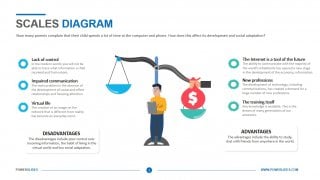
Scales Diagram
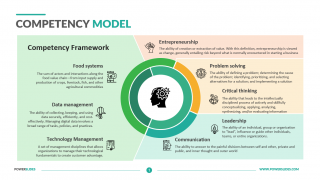
Competency Model

Onboarding Checklist

Gainsharing
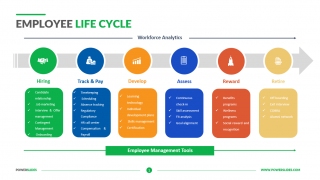
Employee Life Cycle
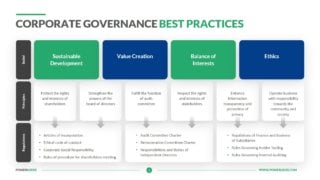
Corporate Governance Best Practices

Project Governance

A/B Testing Funnel

Bottom Up vs Top Down
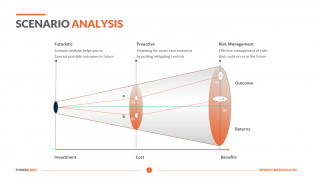
Scenario Analysis
You dont have access, please change your membership plan., great you're all signed up..., verify your account.
PowerSlides.com will email you template files that you've chosen to dowload.
Please make sure you've provided a valid email address! Sometimes, our emails can end up in your Promotions/Spam folder.
Simply, verify your account by clicking on the link in your email.

Knowledge Management System
Feb 03, 2012
90 likes | 313 Views
Knowledge Management(KM) is the hottest topics of the internet world today. It is the process where organizations create value from their intellectual and knowledge based assets.
Share Presentation
- knowledge management
- explicit knowledge
- produce knowledge
- knowledge management system
- cross platform computer environment

Presentation Transcript
Michael Moody Knowledge Management System
Knowledge Management System • Knowledge Management(KM) is the hottest topics of the internet world today. It is the process where organizations create value from their intellectual and knowledge based assets.
Knowledge Management System • In General, knowledge can be classified into two types: • 1.Explicit Knowledge • 2.Tacit Knowledge
Knowledge Management System • Explicit Knowledge: Wikipedia says, Explicit knowledge can be articulated, stored and codified in a certain media.Explicit Knowledge can also be easily transmitted into others. • Tacit Knowledge: Tacit knowledge is a knowledge which is diffucult to transfer to another person by means of verbalising and writing it.It is just opposite to Explicit knowledge where people are not aware of the knowledge they possess.
Knowledge Management System • Knowledge management should meet the minimum demands like knowledge sharing, collection , transferance and storage.Knowledge management system possibly includes: 1.Database. 2.Groupware. 3.Files management system. 4.E-mail server. 5.Schedule Management Software. 6.Cross Platform Computer Environment. 7.Analyzing Software to produce knowledge.
Knowledge Management System • Conclusion: • The basic idea behind this knowledge management system is to enable employees to access the company's documents base of facts, solutions and sources of information.
- More by User

KNOWLEDGE MANAGEMENT
POWER SECTOR WESTERN REGION WELCOMES YOU TO A PRESENTATION ON. KNOWLEDGE MANAGEMENT. KNOWLEDGE MANAGEMENT. HE WHO KNOWS NOT , AND KNOWS NOT THAT HE KNOWS NOT . He is a Fool. SHUN him. HE WHO KNOWS NOT, AND KNOWS THAT HE KNOWS NOT He is Ignorant. TEACH him .
645 views • 25 slides

Knowledge Management System in Healthcare Industry
Knowledge Management System in Healthcare Industry. Introduction. Healthcare professionals are always in situations where they have to think fast and process an array of diagnostic test results, medications and past treatment responses in order to make decisions.
670 views • 22 slides
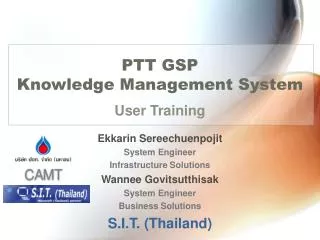
PTT GSP Knowledge Management System
PTT GSP Knowledge Management System. Ekkarin Sereechuenpojit System Engineer Infrastructure Solutions Wannee Govitsutthisak System Engineer Business Solutions S.I.T. (Thailand). User Training. Contents. KMS Design Overview KMS Portal Facilities KMS Features and Usages
602 views • 35 slides

KNOWLEDGE MANAGEMENT SYSTEM
KNOWLEDGE MANAGEMENT SYSTEM. Saul Guerrero Head of Technical Development ACF-UK. Where are we now and where do we want to be?. the extent to which knowledge is internalised by practitioners to take practical decisions, supported by a high degree of personal experience.
291 views • 13 slides
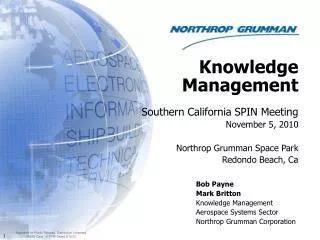
Knowledge Management
Knowledge Management. Southern California SPIN Meeting November 5, 2010 Northrop Grumman Space Park Redondo Beach, Ca. Bob Payne Mark Britton Knowledge Management Aerospace Systems Sector Northrop Grumman Corporation. Approved for Public Release, Distribution Unlimited:
1.04k views • 33 slides
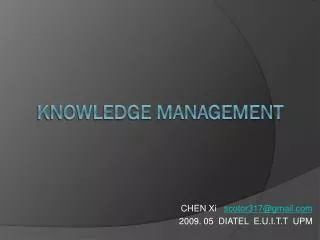
CHEN Xi [email protected] 2009. 05 DIATEL E.U.I.T.T UPM . Knowledge Management. Definition. Difference between Data, Information and Knowledge. Key Point to distinguish : the level of abstraction being considered . Definition.
511 views • 21 slides

Reportable Conditions Knowledge Management System (RCKMS)
Reportable Conditions Knowledge Management System (RCKMS). VMCOP Workgroup Sep 17, 2013. RCKMS Meeting Agenda. Overview Architecture Pilot – CDC R&D Lab Information Requirements Production implementation Questions . Overview. History.
454 views • 30 slides
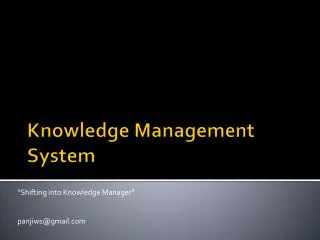
“Shifting into Knowledge Manager” [email protected]. Knowledge Management System . Our Roadmap. Management. Week 11. Knowledge . Week 12. Delivery Technology . Week 13. Fusion . Week 14. Agenda. KMS Concept Library and KMS Paper discussion Summary. Two Kinds of Knowledge.
943 views • 62 slides

Knowledge Management. MIS 650. Course Objectives. Arrive at a working definition of knowledge. Justify the need for a knowledge management system. Build a team and leadership for building a KMS. Building a KMS prototype. Evaluating KMS. Course outline. Knowledge management. Module A
452 views • 20 slides

Knowledge Management. Marleen Steele Training Manager PennDOT. Knowledge Loss at PENNDOT. Attrition Memory Loss Change Management Organization Environment Consultants. What is KM?. Information in action Intellectual capital
537 views • 31 slides
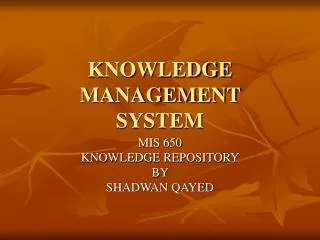
KNOWLEDGE MANAGEMENT SYSTEM. MIS 650 KNOWLEDGE REPOSITORY BY SHADWAN QAYED. Introduction. Knowledge management has been rapidly growing in the last few years, gaining interest from a lot of different organizations.
698 views • 11 slides

KNOWLEDGE MANAGEMENT. M.M. Babu Narayanan Additional Director, CPRI [email protected].
403 views • 2 slides

The ISN Knowledge Management System
INTERNATIONAL RELATIONS AND SECURITY NETWORK Managing information, sharing knowledge. The ISN Knowledge Management System. The ISN. Free international public service Run by the Center for Security Studies (CSS) Funded by the Swiss government and ETH Zurich Independent source of information
329 views • 18 slides

INTERNATIONAL RELATIONS AND SECURITY NETWORK Managing information, sharing knowledge. The ISN Knowledge Management System. Chris Pallaris ISN Chief Editor. The ISN’s Mission.
318 views • 16 slides

Knowledge Management. Lecturer: Mr. A.J. Burger RIS609. Knowledge is power! [Sir Francis Bacon]. Module Outcomes. Knowledge management principles and concepts. Technologies for knowledge management.
380 views • 7 slides

Knowledge Management. BY. C S R PRABHU. Deputy Director General. Ministry of Communications and Information Technology NATIONAL INFORMATICS CENTRE HYDERABAD. Knowledge Management. Definition.
506 views • 25 slides

Complex Adaptive Knowledge Management System
Complex Adaptive Knowledge Management System. Supervisors: Kurt April (Knowledge Management) Sonia Berman (Databases) Anet Potgieter (Artificial Intelligence). Structure of Talk. Overview of project Knowledge Engineering Data Mining Adaptive Presentation and Visualisation
503 views • 22 slides

Knowledge Management. What is Knowledge Management ?. Knowledge Management is the systematic management of vital knowledge and its associated processes of creation, organization, diffusion, use and exploitation . - David Skyrme. Stages from Data to Knowledge. wisdom.
614 views • 17 slides
- Knowledge Management
- Powerpoint Templates
Design Services
Business PPTs
Business Plan
Introduction PPT
Self Introduction
Startup Business Plan
Cyber Security
Digital Marketing
Project Management
Product Management
Artificial Intelligence
Target Market
Communication
Supply Chain
Google Slides
Research Services
All Categories
Knowledge Management PowerPoint Templates
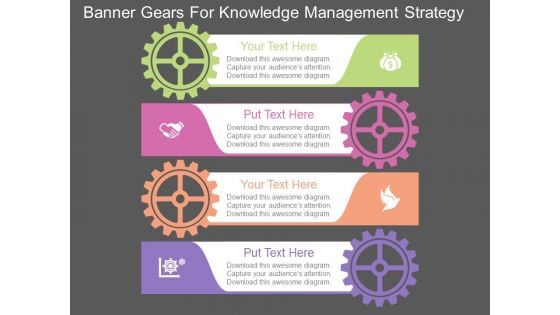
Banner Gears For Knowledge Management Strategy Powerpoint Template
This PowerPoint slide contains graphics of gears banners with icons. This PPT slide helps to exhibit knowledge management strategy. Use this business slide to make impressive presentations.
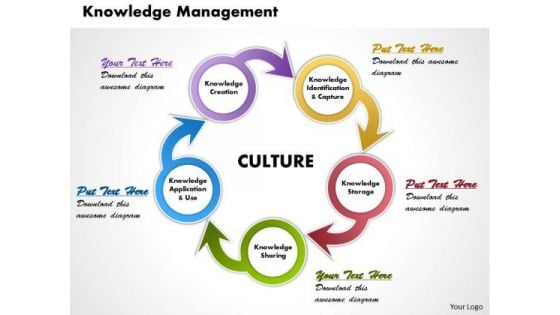
Knowledge Management Business PowerPoint Presentation
Get The Doers Into Action. Activate Them With Our Knowledge Management Business Powerpoint Presentation Powerpoint Templates.

Business Diagram Banner For Knowledge Management Technology PowerPoint Templates
Graphic of three banners has been used to design this business diagram. This diagram template contains the concept of knowledge management. Use this diagram for technology and business related presentations.

Books For Knowledge Management Strategy Powerpoint Slides
Visually support your presentation with our above template containing graphic of colorful books with icons. It helps to portray concepts like education and knowledge. Etch your views in the brains of your audience with this diagram slide.
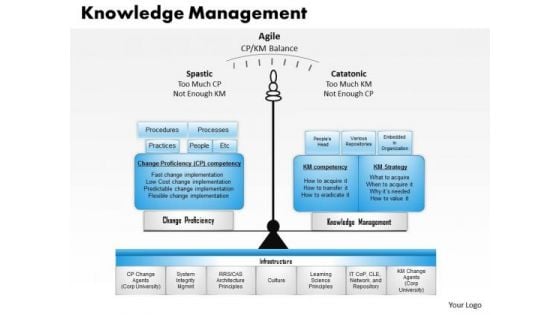
Business Framework Knowledge Management PowerPoint Presentation 1
This diagram displays framework of knowledge management. This professional slide contains graphics of balancing scale depicting balance between change proficiency and knowledge management. Use this business diagram to define process of knowledge management in organizations.

Pencils For Knowledge Management Strategy PowerPoint Template
Create dynamic presentations with our professional template containing graphic of pencils. This diagram represents the concept of knowledge management and strategy. Download this template to leave permanent impression on your audience.
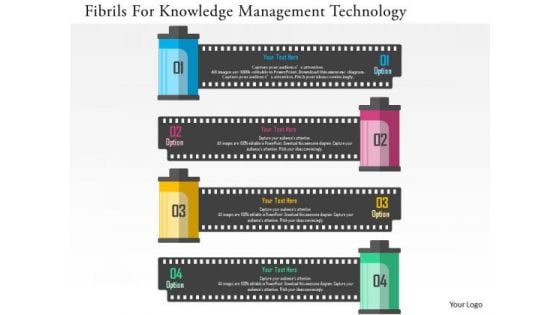
Business Diagram Filmrolls For Knowledge Management Technology Presentation Template
This business diagram has been designed with graphics of film rolls. You may use this slide to depict marketing options. Download this diagram slide to make impressive presentations.
Ratings and Reviews
Most relevant reviews, by nomingua.
May 24, 2021
by Kirti Jindal
May 29, 2021
by Ankita Jhamb
May 30, 2021
by bayaraaa
June 2, 2021
June 1, 2021
May 31, 2021
June 3, 2021
- You're currently reading page 1


COMMENTS
May 18, 2016 • Download as PPTX, PDF •. 78 likes • 88,736 views. Puja Shrivastav. This presentation describes, knowledge management, process of knowledge management, Models of knowledge management, Benefits of knowledge management. Read more. 1 of 20. Download now. 5/18/2016. Knowledge management - Download as a PDF or view online for free.
The document provides an introduction to the topic of knowledge management (KM) through several presentations. It discusses the history and definitions of KM, elements of a KM initiative including people, processes and technology, and the importance of KM for competitive advantage. It also covers the evolution of KM, the differences between ...
Knowledge Management System & Process PPT Presentation. Knowledge management relates to strategic and operational management tasks and activities that deal with the handling and management of knowledge in a company. The task is to organize the knowledge base and how to deal with knowledge. Companies also speak of organizational knowledge ...
The phases of the Zack model are acquisition, refinement, storage/retrieval, distribution, and presentation. Bukowitz and William Model (2000): ... Knowledge management systems have evolved from a useful tool to optimize KM processes to an integral component of KM itself. Today, organizations rely on KM systems to perform many of the functions ...
Download ppt "Chapter 9 Knowledge Management." Learning Objectives Define knowledge and describe the different types of knowledge. Describe the characteristics of knowledge management. Describe the knowledge management cycle. Describe the technologies that can be utilized in a knowledge management system. Describe the activities of the chief ...
Knowledge management (KM) is the process of identifying, organizing, storing and disseminating information within an organization. When knowledge is not easily accessible within an organization, it can be incredibly costly to a business as valuable time is spent seeking out relevant information versus completing outcome-focused tasks.
1) The document discusses knowledge management systems and knowledge-based expert systems. It describes key capabilities like leveraging existing knowledge and creating new knowledge to position companies favorably in markets. 2) Important reasons for actively managing knowledge are to facilitate decision-making, build learning organizations ...
This is a knowledge management technologies ppt powerpoint guide. This is a ten stage process. The stages in this process are extranets, groupware, document management, web conferencing, knowledge refinement, data warehouse, decision system, workflow, intranets, kaca, knowledge management. Slide 1 of 7.
Template 5: Knowledge Management Process Model PPT ... To achieve this goal, it is necessary to classify and catalogue information and establish knowledge management systems. Dissemination: The dissemination process aims to ensure that the company benefits from the information being shared.
Chapter 9 Knowledge Management and Specialized Information Systems. Principles and Learning Objectives • Knowledge management allows organizations to share knowledge and experience among managers and employees • Discuss the differences among data, information, and knowledge • Describe the role of the chief knowledge officer (CKO) • List some of the tools and techniques used in ...
Presentation on theme: "Knowledge Management Systems"— Presentation transcript: 1 Knowledge Management Systems Arvind Devare - 16-H-03 Brijesh Goel - 16-H ... 10 Structure The structure of the knowledge management system is dependent on the business strategy of the organization. The final structure needs to have alignment of technology ...
Knowledge Management Presentation - Download as a PDF or view online for free. ... Knowledge management systems (KMS) aim to support knowledge generation, codification, and transfer in organizations. Various technologies can provide value-adding capabilities to boost and entrench knowledge management, including information technology ...
Benefits of a knowledge management system. A well-implemented knowledge management system can greatly enhance productivity by streamlining access to important information. When I've a centralized repository for all relevant data, it reduces the time spent searching for documents or guidelines. This streamlined access means I can focus more on ...
This is a knowledge management system life cycle ppt presentation. This is a eight stage process. The stages in this process are evaluate existing infrastructure, set up km team, knowledge capture, design km blueprint, verify and validate km system, implement km system, manage change and rewards, evaluate performance and alignment.
Use templates, examples and guidelines for these and many other Knowledge Management models in a PowerPoint presentation. Competitive Advantage Know-How. Knowledge management focuses on the various skill aspects of your employees. The question is how personal and professional capabilities can best be used to improve the quality in your company.
Presentation Transcript. KNOWLEDGE MANAGEMENT SYSTEM MIS 650 KNOWLEDGE REPOSITORY BY SHADWAN QAYED. Introduction • Knowledge management has been rapidly growing in the last few years, gaining interest from a lot of different organizations. • Starting from 1997, a huge selection of books, magazines, articles and websites have come onto the ...
Knowledge management is the organization, capture, use, and measurable impact of a group's collective knowledge. In the business world, knowledge management also includes maintaining a company knowledge base or portal. Only a few initiatives are able to truly transform how an organization operates, and knowledge management is one of them. The knowledge management category represents ...
This is a knowledge management system life cycle ppt presentation. This is a eight stage process. The stages in this process are evaluate existing infrastructure, set up km team, knowledge capture, design km blueprint, verify and validate km system, implement km system, manage change and rewards, evaluate performance and alignment.
Knowledge management. Dec 24, 2012 • Download as PPTX, PDF •. 279 likes • 192,510 views. AI-enhanced description. Sehar Abbas. This document provides an overview of knowledge management. It defines data, information, and knowledge and describes explicit and tacit knowledge. It discusses the history of knowledge management from the 1970s ...
KNOWLEDGE MANAGEMENT SYSTEM PPT 1 (1) - Free download as Powerpoint Presentation (.ppt / .pptx), PDF File (.pdf), Text File (.txt) or view presentation slides online. This document is a project report on a study of a knowledge management system submitted for a master's degree. It includes an introduction to knowledge management systems and how ...
An Image/Link below is provided (as is) to download presentation Download Policy: ... Michael Moody Knowledge Management System. Knowledge Management System • Knowledge Management(KM) is the hottest topics of the internet world today. It is the process where organizations create value from their intellectual and knowledge based assets.
1. 2. Presenting the fantastic collection of professionally designed knowledge management PowerPoint templates. Using this set of PPT slides can encourage the concept of knowledge in your workplace. With the help of these engaging PowerPoint templates, you can create an outstanding presentation on knowledge management and impress your viewers.
15. Knowledge management is a fundamental practice for any organization to survive in the 21st century and key to organization's success The major components are people, processes and systems and they are interconnected, functioning together to achieve a common goal. Processes are all activities required to create new knowledge and manage the ...
Oct 20, 2014 • Download as PPT, PDF •. 78 likes • 45,343 views. AI-enhanced description. Elijah Ezendu. Knowledge management systems (KMS) aim to support knowledge generation, codification, and transfer in organizations. Various technologies can provide value-adding capabilities to boost and entrench knowledge management, including ...
The rules require comparable disclosures by foreign private issuers on Form 6-K for material cybersecurity incidents and on Form 20-F for cybersecurity risk management, strategy, and governance. The final rules will become effective 30 days following publication of the adopting release in the Federal Register.